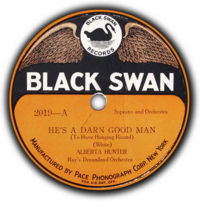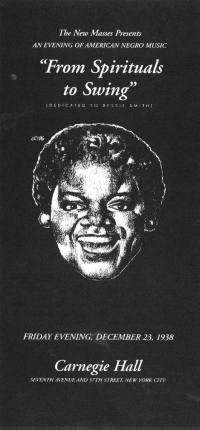
January 29, 2008
retuning for white audiences - more sister rosetta tharpe
Posted by dogpossum on January 29, 2008 11:23 AM in the category academia and lindy hop and other dances and music

Helen has asked for specific details about the tuning of Tharpe's guitar in her comment here. Below is a big fat quote from an article called 'From Spirituals to Swing: Sister Rosetta Tharpe and Gospel Crossover' by Gayle Wald (published in 'American Quarterly', vol 55, no.3 September 2003), pgs 389-399. This is where I read that note about Tharpe's tuning - hope it's useful, Helen.
Wald's article is mostly about Tharpe's movement from black gospel music to the white jazz/blues/pop mainstream. Tharpe is taken as an example illustrating wider points about culture and music during this period. It's a really interesting read.
Although Tharpe arrived in New York already highly credentialed in Pentecostal terms, Sammy Price, Decca's house pianist and recording supervisor at the time Tharpe recorded "Rock Me," apparently wasn't feeling any of this joy. Tharpe, he recalled in his 1990 autobiography, "tuned her guitar funny and sang in the wrong key." In all likelihood Price was referring to Tharpe's use of vestapol (sometimes called 'open D') tuning popular among blues musicians in the Mississippi Delta region. (Muddy Waters is among the many blues guitarists, for example, who learned vestapol technique in the 1930s, when he was growing up in Clarksdale, Mississippi.) As common as it was in the South, however, vestapol tuning could sound distinctly crude and out-of-place in the context of northern jazz bands. By his own account, Price, who later went on to record several hits with Tharpe, refused to play with her until she used a capo, the bar that sits across the fingerboard and changes the pitch of the instrument. "With a capo on the fret," he explained, "it would be a better key to play along with, a normal jazz key."
Price's brief story of the carpo as a normalizing technology is rich with implications for the discussion of what 'crossing over' to the realm of popular entertainment might have meant for Tharpe. Resonant of southern black communities and of musicians who honed their craft in churches as well as on back porches - musicians Hammond quite unself-consciously called 'unlettered' - Tharpe's 'funny' guitar playing introduced, to Price's ear, an apparently unassimilable element into the prevailing sounds of urban jazz. It's also possible that Price was demanding that Tharpe sing at a higher pitch, to conform with popular as well as commercial expectations that high pitch evidences a correspondingly 'higher' degree of femininity. In any case, and as Price suggests, Tharpe quite literally had to adjust her guitar and singing techniques to make commercially popular, 'secular' records that would earn her an audience beyond the relatively small market of consumers of 'religious music.' The 'makeover' of Tharpe's sound also has important gender and class implications less obvious from Price's comment. In bringing her sound more into line with the sounds of commercial jazz, Tharpe would not only have to change her tuning, but 'change her tune' as far as her performance of femininity was concerned.

The 'Hammond' referred to in the article is John Hammond, an important figure in the promotion and management of a number of big jazz musicians. Gunther Schuller's book 'The Swing Era' reads almost as a history of Hammond's career. I think it's important to note that this one white man was important for his influence on the developing jazz and swing music industry. His selection and then promotion of specific artists shaped the recording industry, popular tastes and the white mainstream's understanding of and access to black music during this period. As the race records and black-run radio stations were forced out of the industry by white competitors and blatantly racist media regulation, black artists had less and less control of their own representation in mass media, and black musical culture was mediated by white corporate and cultural interests.

All of this makes for fabulous, fascinating reading. It is, though, all about America. I'm not sure how much (if any of it) can be translated to the Australian context. But that would make for interesting research in itself, particularly when you keep in mind that jazz in Australia is necessarily the product of cultural transmission - black music filtered through mainstream American recording and sheet music industries to white mainstream audiences and musicians and white Australian musicians and audiences. Sure, there were musicians making jazz in Australia (people like Graeme Bell of course), but I've been thinking about 'authenticity' and jazz in such a transplanted context... particularly as I've read recently somewhere (goddess knows where - I'd have to retrace my steps) that music tends to reflect the vocal patterns and intonations and rhythms of the culture in which it develops. So, we could draw from this the conclusion that we Australians would play jazz with an Australian accent. It wouldn't sound like American - or black American - jazz. I'm hesitant to make comments about the relative value of localised jazz, but it's an issue hanging in the background there...
But back to Hammond. John Hammond of course organised the concert 'From Spirituals to swing' at Carnegie Hall in New York in 1938 (you can see the artists here, in a recording of the concert) . This concert featured a bunch of super big artists (Jimmy Rusher, Joe Turner, Mitchell's Christian Singers, Albert Ammons, Sidney Bechet, Count Basie, Benny Goodman). It's goal was a combination of musical 'education' for the white mainstream and - indubitably, considering Hammond's impressive business sense - promotion of black music to new white audiences/consumers.
I'm interested in this concert and in Tharpe's cross-promotion to the mainstream as an example of cultural transmission - I'm fascinated by the way music and dance move between cultures. I'm also really interested in the uses of power in this process. Is it appropration? Stealing? Poaching? To quote (ad nauseum), Hazzard Gordon, we have to ask "who has the power to steal from whom?" when we're looking at this process.
I''ve been writing about the way different cultures not only 'take' dance steps or songs from other cultures or traditions, but also the way they then adapt these 'found' texts to suit their own cultural/social needs, values, etc.
I've argued all through my work that we can see the social heirarchy of the US in the reworking of dances and songs. What did they need to do to make these texts palatable for white audiences? With Tharpe it was 'retuning' her guitar and voice. With lindy hop, it was 'desexualising' and 'tidying' up the basic steps. Or at least presenting a different type of sexual performance.
Some interesting references
There's a really great page discussing race records that includes audio files, images and written text here on the NPR site.
There's also a pbs (US) site attached to the Ken Burns Jazz doco discussing race records.
For a (very nice) academic discussion, see David Suisman's article called 'Co-workers in the kingdom of culture: Black Swan Records and the political economy of African American music' (The Journal of American History vol 90, no.4, March 2004, p 1295-1324) which discusses the 'race records' of the period and the racialised nature of the American recording industry.
You can also walk through this article via the JAH's fantastic site (complete with images, sound files and other wonderful things). This is one site that really ROCKS.
Derek W. Vaillant has written a really interesting article about black radio in Chicago in the 20s and 30s which discusses these issues in greater detail ('Sounds of Whiteness: Local radio, racial formation and public culture in Chicago 1921-1935', American Quarterly vol 54 no. 1, March 2002 p25-66).
Katrina Hazzard Gordon has written quite a bit about African American dance culture. Here are a couple of references:
Hazzard-Gordon, Katrina. "African-American Vernacular Dance: Core Culture and Meaning Operatives." Journal of Black Studies 15.4 (1985): 427-45.
---. Jookin': The Rise of Social Dance Formations in African-American Culture. Philadelphia: Temple University Press, 1990.
Read more about John Hammond, look at photos and listen to music here on this Jerry Jazz Musician page.
Wald, Gayle. "From Spirituals to Swing: Sister Rosetta Tharpe and Gospel Crossover" American Quarterly vol 55, no.3 (September 2003): 389-399.




